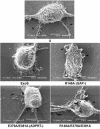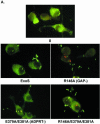Characterization of Pseudomonas aeruginosa exoenzyme S as a bifunctional enzyme in J774A.1 macrophages
- PMID: 12933877
- PMCID: PMC187317
- DOI: 10.1128/IAI.71.9.5296-5305.2003
Characterization of Pseudomonas aeruginosa exoenzyme S as a bifunctional enzyme in J774A.1 macrophages
Abstract
Pseudomonas aeruginosa exoenzyme S (ExoS) is a type III secretion (TTS) effector, which includes both a GTPase-activating protein (GAP) activity toward the Rho family of low-molecular-weight G (LMWG) proteins and an ADP-ribosyltransferase (ADPRT) activity that targets LMWG proteins in the Ras, Rab, and Rho families. The coordinate function of both activities of ExoS in J774A.1 macrophages was assessed by using P. aeruginosa strains expressing and translocating wild-type ExoS or ExoS defective in GAP and/or ADPRT activity. Distinct and coordinated functions were identified for both domains. The GAP activity was required for the antiphagocytic effect of ExoS and was linked to interference of lamellopodium and membrane ruffle formation. Alternatively, the ADPRT activity of ExoS altered cellular adherence and morphology and was linked to effects on filopodium formation. The cellular mechanism of ExoS GAP activity included an inactivation of Rac1 function, as determined in p21-activated kinase 1-glutathione S-transferase (GST) pull-down assays. The ADPRT activity of ExoS targeted Ras and RalA but not Rab or Rho proteins, and Ral binding protein 1-GST pull-down assays identified an effect of ExoS ADPRT activity on RalA activation. The results from these studies confirm the bifunctional nature of ExoS activity within macrophages when translocated by TTS.
Figures






Similar articles
-
Examination of the coordinate effects of Pseudomonas aeruginosa ExoS on Rac1.Infect Immun. 2005 Sep;73(9):5458-67. doi: 10.1128/IAI.73.9.5458-5467.2005. Infect Immun. 2005. PMID: 16113262 Free PMC article.
-
Independent and coordinate effects of ADP-ribosyltransferase and GTPase-activating activities of exoenzyme S on HT-29 epithelial cell function.Infect Immun. 2001 Sep;69(9):5318-28. doi: 10.1128/IAI.69.9.5318-5328.2001. Infect Immun. 2001. PMID: 11500401 Free PMC article.
-
ADP-ribosylation and functional effects of Pseudomonas exoenzyme S on cellular RalA.Biochemistry. 2002 Jul 30;41(30):9680-7. doi: 10.1021/bi025826n. Biochemistry. 2002. PMID: 12135390
-
Pseudomonas aeruginosa exoenzyme S, a bifunctional type-III secreted cytotoxin.Int J Med Microbiol. 2000 Oct;290(4-5):381-7. doi: 10.1016/S1438-4221(00)80047-8. Int J Med Microbiol. 2000. PMID: 11111915 Review.
-
Pseudomonas aeruginosa ExoS and ExoT.Rev Physiol Biochem Pharmacol. 2004;152:79-92. doi: 10.1007/s10254-004-0031-7. Epub 2004 Aug 24. Rev Physiol Biochem Pharmacol. 2004. PMID: 15375697 Review.
Cited by
-
The impairment of methylmenaquinol:fumarate reductase affects hydrogen peroxide susceptibility and accumulation in Campylobacter jejuni.Microbiologyopen. 2014 Apr;3(2):168-81. doi: 10.1002/mbo3.158. Epub 2014 Feb 7. Microbiologyopen. 2014. PMID: 24515965 Free PMC article.
-
Modulation of host cell endocytosis by the type III cytotoxin, Pseudomonas ExoS.Traffic. 2008 Nov;9(11):1948-57. doi: 10.1111/j.1600-0854.2008.00808.x. Epub 2008 Aug 4. Traffic. 2008. PMID: 18778330 Free PMC article.
-
Persistent infection with Pseudomonas aeruginosa in ventilator-associated pneumonia.Am J Respir Crit Care Med. 2008 Sep 1;178(5):513-9. doi: 10.1164/rccm.200802-239OC. Epub 2008 May 8. Am J Respir Crit Care Med. 2008. PMID: 18467510 Free PMC article.
-
Yersinia pseudotuberculosis spatially controls activation and misregulation of host cell Rac1.PLoS Pathog. 2005 Oct;1(2):e16. doi: 10.1371/journal.ppat.0010016. Epub 2005 Oct 14. PLoS Pathog. 2005. PMID: 16228016 Free PMC article.
-
Relative contributions of Pseudomonas aeruginosa ExoU, ExoS, and ExoT to virulence in the lung.Infect Immun. 2004 Dec;72(12):6969-77. doi: 10.1128/IAI.72.12.6969-6977.2004. Infect Immun. 2004. PMID: 15557619 Free PMC article.
References
-
- Aktories, K., C. Mohr, and G. Koch. 1992. Clostridium botulinum C3 ADP-ribosyltransferase. Curr. Top. Microbiol. Immunol. 175:115-131. - PubMed
-
- Allen, W. E., G. E. Jones, J. W. Pollard, and A. J. Ridley. 1997. Rho, Rac and Cdc42 regulate actin organization and cell adhesion in macrophages. J. Cell Sci. 110:707-720. - PubMed
-
- Caron, E., and A. Hall. 1998. Identification of two distinct mechanisms of phagocytosis controlled by different Rho GTPases. Science 282:1717-1721. - PubMed
-
- Coburn, J., R. T. Wyatt, B. H. Iglewski, and D. M. Gill. 1989. Several GTP-binding proteins, including p21c-H-ras, are preferred substrates of Pseudomonas aeruginosa exoenzyme S. J. Biol. Chem. 264:9004-9008. - PubMed
Publication types
MeSH terms
Substances
Grants and funding
LinkOut - more resources
Full Text Sources
Other Literature Sources
Research Materials
Miscellaneous

